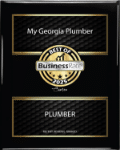
Prevent frozen pipes with a few simple tips.
Winter brings frigid temperatures for much of the country, and when temperatures plummet, the water that supplies your home’s faucets and fixtures is in danger of freezing inside your pipes. Because water expands as it turns to ice, frozen pipes are prone to bursting, which can result in costly water and plumbing damage throughout your home. At the highest risk of freezing are pipes that run against exterior walls and those in unheated or uninsulated places, such as the attic, basement, or garage. Prevent frozen pipes early to avoid hefty damage.
Before the temperatures outside dip below freezing, it’s important to understand how to prevent frozen pipes and take the necessary steps to winterize your home. Read on to learn a few simple tricks to protect your pipes from freezing and keep the water running in cold weather. We’ll also walk you through what to do if you think your pipes might be frozen and how to thaw them to ward off a bigger home disaster.
1. Disconnect garden hoses.
After you finish tending to your garden for the season, disconnect, drain, and store your hoses. Close any shut-off valves that supply outdoor hose bibs and open the faucet outside to drain the line. Keep it open throughout the winter to allow space for any water that remains in the pipe to expand. Consider using faucet covers ($4, The Home Depot) throughout the colder months for extra protection against frozen pipes. Additionally, drain water from any sprinkler supply lines following the manufacturer’s directions.
2. Insulate your pipes.
Pipe insulation is fairly inexpensive and widely available at home improvement stores. Consider insulating any pipes located in unheated areas, such as in the attic, basement, crawl spaces, or garage. In extreme cold, pipes underneath kitchen and bathroom sinks are also vulnerable to freezing. Apply foam insulation liberally to provide a buffer against frigid temperatures. Wrapping your pipes in heat tape or thermostat-controlled heat cables ($34, Walmart) can also keep them warm enough to prevent freezing.
3. Seal any air leaks.
Inspect your home for any cracks or openings that could let in cold air. Seal any holes around the piping in interior or exterior walls and the sill plates, where your home rests on its foundation. Additionally, since leaving your garage open is like creating a giant air leak, always keep the door closed unless you’re going in or out.
4. Open doors and cabinets.
Ensure warm air can circulate evenly throughout your home during cold snaps. Leave interior doors ajar and open kitchen and bathroom cabinets to distribute heat consistently around rooms. Remove any household chemicals or potentially harmful cleaners from open cabinets if you have small children or pets at home.
5. Let faucets drip.
Even a small trickle of water can prevent ice from forming inside your pipes. When it’s bitter cold outside, start a drip of water from all faucets served by exposed pipes. Leaving a few faucets running slightly will also relieve pressure inside the pipes and help prevent a rupture in the event that the water inside freezes.
6. Keep a consistent temperature.
Set your thermostat to maintain a consistent temperature throughout the day and night. In normal weather, bumping down your thermostat at night or when you’re not at home can help save on heating costs, but in extreme cold, maintaining a steady temperature is key to keeping your pipes free of ice. And if you’ll be away from home during cold weather, ensure your thermostat is set to at least 55°F. The few extra dollars you’ll spend on your utility bill will be well worth the thousands you’ll save by avoiding a burst pipe.
What to Do if Your Pipes Freeze
If you suspect you have a frozen pipe, start by turning on the faucet. If only a drip or trickle of water flows out, you likely have an ice blockage. Next, carefully inspect the exposed pipe for any cracks or breaks.
Attempting to thaw a pipe that has already burst can cause water to flow out and flood your home.
If the pipe is still intact, turn on the faucet to allow water to flow through as the ice melts. Gently apply heat to the frozen section of pipe, using a heating pad, hairdryer, space heater, or warm, damp towels.
If you are unable to access or safely thaw the frozen pipe, call a licensed plumber right away.
My Georgia Plumber is always here to help! Call 770-592-0081 or schedule online for any frozen pipe issues.











